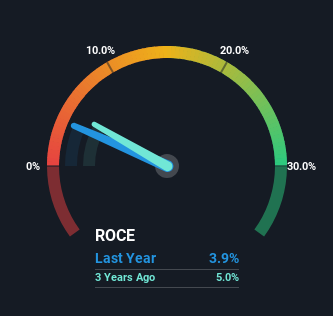Some Investors May Be Worried About Nitto Kohki's (TSE:6151) Returns On Capital

If we're looking to avoid a business that is in decline, what are the trends that can warn us ahead of time? When we see a declining return on capital employed (ROCE) in conjunction with a declining base of capital employed, that's often how a mature business shows signs of aging. Basically the company is earning less on its investments and it is also reducing its total assets. And from a first read, things don't look too good at Nitto Kohki (TSE:6151), so let's see why.
Understanding Return On Capital Employed (ROCE)
If you haven't worked with ROCE before, it measures the 'return' (pre-tax profit) a company generates from capital employed in its business. Analysts use this formula to calculate it for Nitto Kohki:
Return on Capital Employed = Earnings Before Interest and Tax (EBIT) ÷ (Total Assets - Current Liabilities)
0.039 = JP¥2.4b ÷ (JP¥66b - JP¥4.0b) (Based on the trailing twelve months to September 2024).
Therefore, Nitto Kohki has an ROCE of 3.9%. Ultimately, that's a low return and it under-performs the Machinery industry average of 7.9%.
See our latest analysis for Nitto Kohki

Historical performance is a great place to start when researching a stock so above you can see the gauge for Nitto Kohki's ROCE against it's prior returns. If you'd like to look at how Nitto Kohki has performed in the past in other metrics, you can view this free graph of Nitto Kohki's past earnings, revenue and cash flow.
How Are Returns Trending?
In terms of Nitto Kohki's historical ROCE movements, the trend doesn't inspire confidence. About five years ago, returns on capital were 8.3%, however they're now substantially lower than that as we saw above. Meanwhile, capital employed in the business has stayed roughly the flat over the period. Since returns are falling and the business has the same amount of assets employed, this can suggest it's a mature business that hasn't had much growth in the last five years. If these trends continue, we wouldn't expect Nitto Kohki to turn into a multi-bagger.
What We Can Learn From Nitto Kohki's ROCE
In the end, the trend of lower returns on the same amount of capital isn't typically an indication that we're looking at a growth stock. Despite the concerning underlying trends, the stock has actually gained 15% over the last five years, so it might be that the investors are expecting the trends to reverse. Either way, we aren't huge fans of the current trends and so with that we think you might find better investments elsewhere.
One final note, you should learn about the 3 warning signs we've spotted with Nitto Kohki (including 2 which can't be ignored) .
While Nitto Kohki isn't earning the highest return, check out this free list of companies that are earning high returns on equity with solid balance sheets.
If you're looking to trade Nitto Kohki, open an account with the lowest-cost platform trusted by professionals, Interactive Brokers.
With clients in over 200 countries and territories, and access to 160 markets, IBKR lets you trade stocks, options, futures, forex, bonds and funds from a single integrated account.
Enjoy no hidden fees, no account minimums, and FX conversion rates as low as 0.03%, far better than what most brokers offer.
Sponsored ContentValuation is complex, but we're here to simplify it.
Discover if Nitto Kohki might be undervalued or overvalued with our detailed analysis, featuring fair value estimates, potential risks, dividends, insider trades, and its financial condition.
Access Free AnalysisHave feedback on this article? Concerned about the content? Get in touch with us directly. Alternatively, email editorial-team (at) simplywallst.com.
This article by Simply Wall St is general in nature. We provide commentary based on historical data and analyst forecasts only using an unbiased methodology and our articles are not intended to be financial advice. It does not constitute a recommendation to buy or sell any stock, and does not take account of your objectives, or your financial situation. We aim to bring you long-term focused analysis driven by fundamental data. Note that our analysis may not factor in the latest price-sensitive company announcements or qualitative material. Simply Wall St has no position in any stocks mentioned.
About TSE:6151
Nitto Kohki
Develops, manufactures, and sells connecting fluid couplings, labor-saving machine tools, and linear motor driven free piston pumps and other pumps for various applications.
Flawless balance sheet second-rate dividend payer.
Market Insights
Community Narratives




